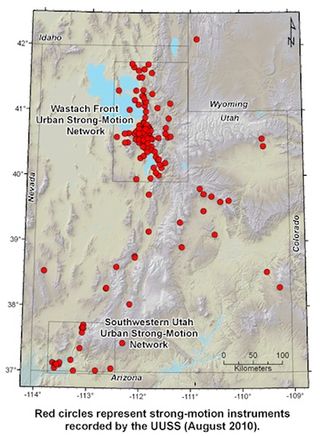
How Earthquakes Make the Ground Go Boom

As earthquake waves ripple through the Earth, the crust buckles, rumbles and roars — both audibly and at infrasonic frequencies, below the range of human hearing.
A new study finds the Earth's surface acts like a speaker for low-frequency vibrations, transmitting an earthquake's infrasonic tumult into the air.
"This is really the first successful model for earthquake infrasound. It means that we can predict what we expect to see from earthquakes versus underground explosions, for example," said study author Steve Arrowsmith, a researcher at Los Alamos National Laboratory in New Mexico. Los Alamos is part of the U.S. monitoring network that operates infrasound stations to monitor nuclear tests in other countries.
Infrasound is emitted only above a quake's hypocenter, the point where a fault begins to rip apart, said Arrowsmith, who plans to present the study results Oct. 25 at the annual meeting of the Acoustical Society of America in Kansas City, Mo.
Researchers have debated the source of infrasound for decades, suggesting it comes from directly above the quake's source or from vibrations in nearby mountains.
A magnitude-4.6 earthquake that occurred Jan. 3, 2011, in Circleville, Utah, gave Arrowsmith and his colleagues the chance to conclude the debate.
Computer modeling by the researchers indicated that most of the low-frequency infrasound comes from earthquake waves pumping the Earth's surface as a piston would. The researchers confirmed their models by studying seismic and infrasound data from the Circleville earthquake. The infrasound was primarily in the range of 1 to 5 Hertz – lower than the inaudible calls of elephants and whales – and peaked at about 70 decibels (about as loud as a vacuum cleaner), Arrowsmith and his colleagues reported in the Oct. 11, 2011, issue of Geophysical Journal International.
Sign up for the Live Science daily newsletter now
Get the world’s most fascinating discoveries delivered straight to your inbox.
Along with monitoring nuclear tests, infrasound could help assess damage immediately after of an earthquake, Arrowsmith said. "After you have a big earthquake, you want to know immediately where to put resources, and you could do that without having to use a lot of seismic stations," he said.
Other natural phenomena that produce infrasonic booms include volcanoes, hurricanes and meteors. Elephants and rhinoceros are among the animals that can hear and communicate in infrasound.
Reach Becky Oskin at boskin@techmedianetwork.com. Follow her on Twitter @beckyoskin. Follow OurAmazingPlanet on Twitter @OAPlanet. We're also on Facebook and Google+.

Most Popular



